Galina Salnikova and Nelli Porseva, a student and teacher at Gymnasium 164 in Zelenogorsk, Russia were featured in their local TV news! (Available only in Russian)
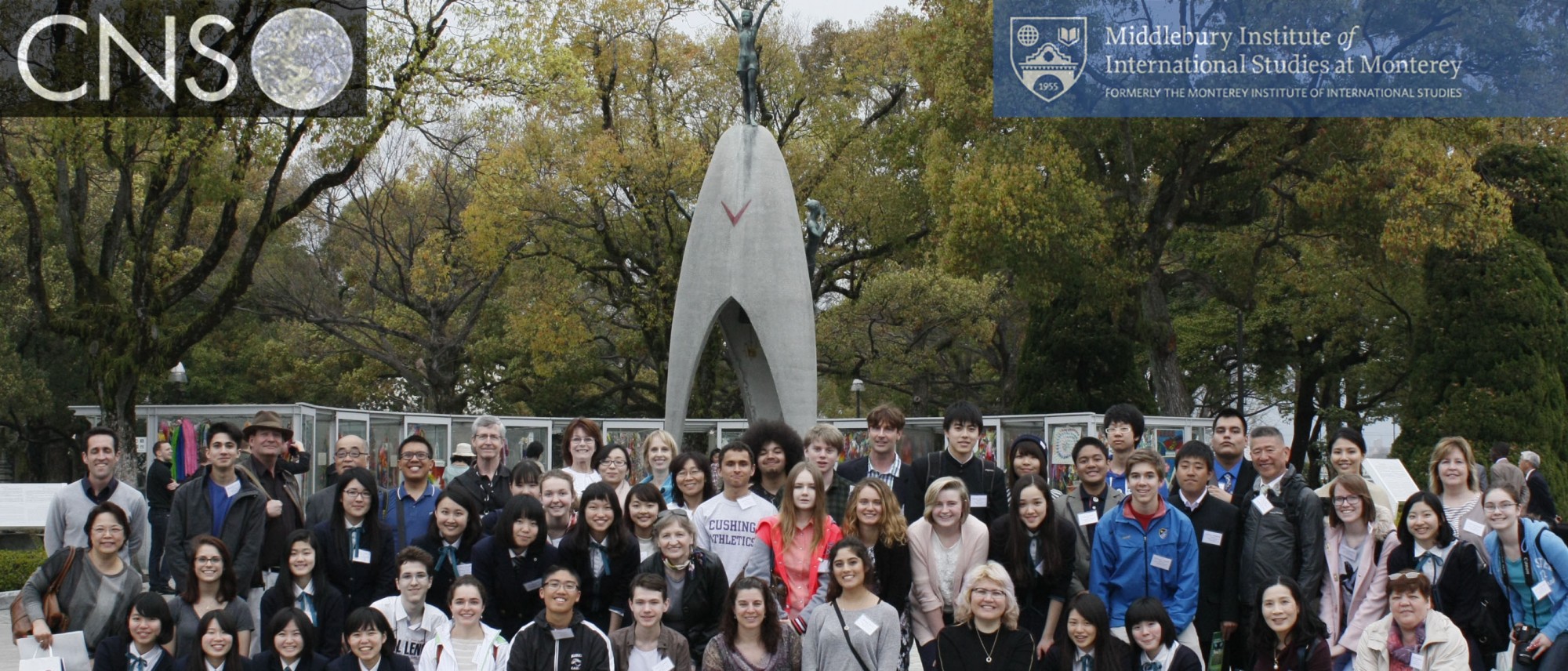
Galina Salnikova and Nelli Porseva, a student and teacher at Gymnasium 164 in Zelenogorsk, Russia were featured in their local TV news! (Available only in Russian)
“I would like to start off by thanking Bill Potter and the James Martin Center for sponsoring this wonderful and unique conference. I have believed for many years now that the only way I would want to deal with this nuclear problem is through education and the education has to start young, at high school. And Bill Potter is going to pioneer in recognizing this best and the most successful program on the way in the country to actually implement it. So, Bill, Congratulations on the wonderful work. I have to tell you also how impressed I was by the talks I heard this morning and I want to thank all the students who gave the talk and all the other high school students who are here and preparing to get the same informed education about this one existential threat to you and your families and to the whole world. I would be remiss if I not also recognize to thank the teachers and the principals with whom you worked to help you prepare for this event. Anything that we can do to encourage the teachers and the principals to move forward on this is critically important. I do not believe we will really deal effectively with the nuclear problem until the youth of our country become fully understanding about how dangerous this is to their future and start to work actively to reduce this danger and to eliminate it.”
Please see Dr. Perry’s entire speech.

MEDIA ADVISORY Contact: Jason Warburg
March 28, 2016 (831) 647-3516
jwarburg@miis.edu
April 15-16 Conference at Santa Catalina High School in Monterey Sponsored by the Middlebury Institute’s James Martin Center for Nonproliferation Studies
Monterey, Calif. – Students and teachers from Japan and Russia will join peers from the United States at a conference on nuclear nonproliferation and disarmament convened by the Middlebury Institute of International Studies at Monterey and featuring former U.S. Secretary of Defense William Perry. The annual conference will take place on April 15-16 at Santa Catalina School in Monterey.
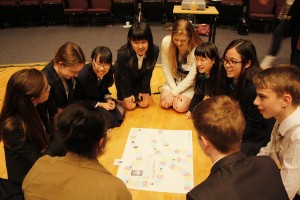
At the 2016 Critical Issues Forum (CIF) conference, students from six Japanese high schools (Hiroshima, Nagasaki, Osaka, Kyoto and Tokyo), three Russian high schools in closed nuclear cities (Lesnoy, Novouralsk, and Zelenogorsk), and seven U.S. high schools in four different states (California, Connecticut, Hawaii, and Wisconsin), are scheduled to present their studies on the topic of “Global Nuclear Vulnerability: Lessons for a More Secure and Peaceful World.” The CIF program is managed by the James Martin Center for Nonproliferation Studies at the Middlebury Institute of International Studies at Monterey.
Dr. William Perry, Secretary of Defense under President Bill Clinton, will participate as a guest speaker at the conference during the morning of April 16, along with his daughter Ms. Robin Perry. Dr. Perry is well known for his nuclear disarmament, nonproliferation and nuclear security leadership, especially for his op-ed pieces advocating a world free of nuclear weapons, co-authored with other former high-ranking governmental officials. His appearance in Monterey is part of his ongoing efforts to draw attention to issues related to nuclear policy and disarmament.
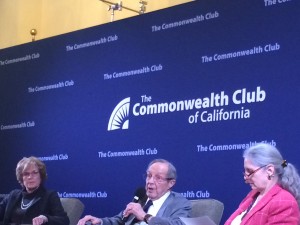
This year’s CIF participants will examine the dangers of the current nuclear weapons situation, and investigate how close we have come to nuclear weapons use. These young leaders from around the world will tackle one of the most pressing and challenging security issues of our time, exploring how international nonproliferation and disarmament regimes are working to prevent nuclear weapons technology from being spread or used.
The April 15-16 CIF conference is the culmination of a semester-long program for high school students that is designed to develop critical thinking skills and to engage students and teachers around issues related to international peace and security. All participating students are expected to present and exchange their findings on their chosen topic in a creative and innovative way, followed by an open discussion centered on a question and answer session with their peers and teachers. Students will also engage in interactive and cross-cultural activities during the conference, and will have the opportunity to interact with graduate students studying nuclear disarmament issues in the Institute’s Nonproliferation and Terrorism Studies program.
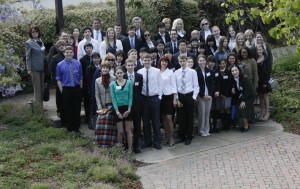
This year’s CIF program is funded by the United States-Japan Foundation, a New York-based organization supporting activities to deepen friendship and understanding between American and Japanese citizens, and the Tokyo Club, Japan’s oldest and most prestigious private club. For more information on the CIF program, please visit the CIF website at sites.miis.edu/criticalissuesforum, and view this short video.
What: Critical Issues Forum
When: April 15 from 8:30 a.m. to 5:00 p.m.
April 16 from 8:30 a.m. to 1:45 p.m.
Where: Mary Johnson Recital Hall, Santa Catalina School
1500 Mark Thomas Drive, Monterey
Contact: Masako Toki 831-915-6162 (mobile)
# # #
The Middlebury Institute of International Studies at Monterey has been preparing graduate professionals for global careers since 1955. Located in Monterey, California, the Institute offers advanced degrees in international business, international education management, international environmental policy, international policy studies, language teaching, localization management, nonproliferation and terrorism studies, public administration, and translation and interpretation, as well as a variety of specialized certificates and programs. The Institute, whose approximately 750 students come from more than 50 countries, is also home to the James Martin Center for Nonproliferation Studies, the Monterey Terrorism Research and Education Program (MonTREP), the Center for the Blue Economy, and the Center for Conflict Studies. Visit www.miis.edu for campus news or to find an expert.
The James Martin Center for Nonproliferation Studies (CNS) strives to combat the spread of weapons of mass destruction (WMD) by training the next generation of nonproliferation specialists and disseminating timely information and analysis. CNS at the Middlebury Institute of International Studies at Monterey is the largest nongovernmental organization in the United States devoted exclusively to research and training on nonproliferation issues. CNS news releases and photos are available at http://www.nonproliferation.org.
Link to the PDF version of the Media Advisory. Click here!
by Masako Toki
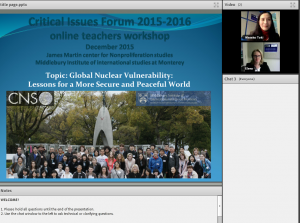
Ms. Elena Sokova, CNS Deputy Director, welcoming CIF teachers at the online workshop
The 2015-16 Critical Issues Forum (CIF) kicked off with an online teachers’ workshop, held during the first and second week of December, the final month of the seventieth anniversary year of the atomic bombing of Hiroshima and Nagasaki. As a flagship education project of the James Martin Center for Nonproliferation Studies (CNS) of the Middlebury Institute of International Studies at Monterey (MIIS), CIF is a unique nonproliferation and disarmament education project for high school teachers and students around the world to promote awareness of the importance of these issues. Ensuring disarmament and nonproliferation education for next generations has become increasingly important; the average age of atomic bomb survivors is now over eighty, and these hibakusha are vital for passing on the memory of the effects of the use of nuclear weapons.
This year’s topic “Global Nuclear Vulnerability: Lessons for a More Secure and Peaceful World,” encourages CIF participants to examine and investigate nuclear “close calls,” human and technical mistakes that nearly led to the accidental or mistaken use of nuclear weapons. Students will explore the current status of nuclear arsenals and how international nonproliferation and disarmament regimes are preventing nuclear weapons from being used. Students will also assess the degree to which the current nonproliferation and disarmament regime is effectively working and contributing to making a safer world. Moreover, students will examine how the recent international environment, such as the deteriorating US-Russia relationship, could increase the risk of the use of nuclear weapons.
Students will need to investigate whether there are any ways to prevent the future use of nuclear weapons, and explore possible pathways toward the goal of total elimination of these weapons. Although some may strongly believe that the total elimination of nuclear weapons is the only solution, students will also need to study if there are practical ways to prevent the use of nuclear weapons while they still exist.
Teachers from Japan, Russia’s closed nuclear cities, and US schools around the country participated in the online workshop. Participants engaged both synchronously with the online workshops and asynchronously, at a later, more convenient for them, given time differences. All workshop sessions were recorded and remain available on the CIF website for asynchronous viewing.
CNS deputy director Ms. Elena Sokova gave welcoming remarks, congratulating the CIF teachers for their important work in disarmament and nonproliferation education for the next generations. She also highlighted the successful spring conference that was held in Hiroshima in April 2015 that commemorated the seventieth anniversary of the atomic bombings.
She emphasized the importance of remembering horrendous human effects of the use of nuclear weapons in Hiroshima and Nagasaki. She delineated the current alarming world nuclear weapons situation and the need for this type of disarmament and nonproliferation education in order to improve the security environment, highlighting the importance of raising awareness among the future leaders, the danger of nuclear weapons, and nuclear vulnerability.
In her remarks, she quoted former US Defense Secretary William Perry’s new book, “My Journey at the Nuclear Brink,” which is directly relevant to this year’s topic. In his book, Dr. Perry introduced six pivotal experiences in his life and lessons about nuclear weapons that he drew from those experiences. And these lessons all contribute to reducing nuclear dangers—also one of the goals of this year’s CIF project.
This year’s teachers’ workshop lectures covered a wide range of topics related to global nuclear vulnerability. Dr. Benoit Pelopidas, a distinguished nonproliferation scholar, provided an introductory lecture to this year’s topic. In a separate lecture, Dr. Pelopidas discussed the case studies of close calls of nuclear weapons, highlighting in particular the Cuban Missile Crisis. In his final lecture, he examined implications of past and present nuclear weapons policies and practices, emphasizing the importance of future leaders, especially high school students, to study this topic in order to understand the nuclear danger and consider how to reduce the nuclear risk.
Other lectures covered global nonproliferation regimes, the current world status of nuclear weapons, the basics of nuclear weapons, the 2015 Review Conference of the Treaty on the Non-Proliferation of Nuclear Weapons (NPT), nuclear disarmament initiatives, and scientific perspectives of nuclear weapons.
Dr. Nikolai Sokov, CNS senior fellow and leading expert of Russian nuclear policy, discussed US-Russia arms control and nuclear policies to help CIF participants better understand the recent heightened tensions between the two countries and its impact on international nuclear nonproliferation regimes.
Dr. Jeffrey Knopf, chair of the Nonproliferation and Terrorism Studies program at MIIS, presented an overview of the current nuclear situation and challenges to nuclear disarmament and nonproliferation. He also highlighted modern nonproliferation concerns and some causes of possible use of nuclear weapons.
Ms. Gaukhar Mukhatzhanova, director of CNS’s International Organization and Nonproliferation Program (IONP), articulated what happened at the 2015 NPT Review Conference, and shared her analysis on the causes of the failure of the Review Conference and uncertainty of the future of disarmament efforts.
Dr. Ferenc Dalnoki-Veress, scientist-in-residence at CNS, explained how nuclear weapons work, breaking down the basic physics behind nuclear science. He also gave a lecture on the impact of the use of nuclear weapons from scientific perspectives.
Mr. Joe Brazda, an IONP research associate, explained international nonproliferation regimes and the role of international organizations.
For the complete lecture video and presentations, visit the CIF website’s teachers’ workshop page: http://sites.miis.edu/criticalissuesforum/2015/12/01/2015-2016-teachers-workshop-lectures/
After teachers have studied these topics using the online materials, they will work with their students at their own schools towards the Spring Conference that will be held at Santa Catalina School in Monterey, California, in April. This year, we expect to have several Japanese high schools from Hiroshima, Nagasaki, Tokyo, and Osaka, several US high schools from around the country, as well as schools from Russia’s closed nuclear cities.
CNS is grateful to the United States-Japan Foundation for their support of CIF.
For more information, please visit CIF website at http://sites.miis.edu/criticalissuesforum
2015-2016 Critical Issues Forum
Useful Resources
Topic: Global Nuclear Vulnerability: Lessons for a More Peaceful World
*Please note that more resources will be added to the section of “This year’s topic-specific resources.”
General resources
Nuclear Threat Initiative Tutorials
http://tutorials.nti.org/table-of-contents/
Melissa Gillis, “Disarmament: A Basic Guide”, United Nations
((NPT–section 4, beginning on page 31)
Which Countries Have Nuclear Weapons-BBC News World-Video
http://www.bbc.co.uk/news/world-24277021
United Nations Audio Visual Library of International Law– NPT
http://legal.un.org/avl/ha/tnpt/tnpt.html
United Nations Disarmament Education
http://www.un.org/disarmament/education/
US State Department–NPT
http://www.state.gov/t/isn/npt/
Nuclear Disarmament Resource Collection
http://www.nti.org/analysis/reports/nuclear-disarmament/
Global Zero Interactive Map
http://www.globalzero.org/map
Nuclear Notebook (for nuclear weapons numbers)
http://bos.sagepub.com/cgi/collection/nuclearnotebook
What is Nuclear?
www.whatisnuclear.com
Nick Touran, “What is Nonproliferation?”
http://www.whatisnuclear.com/articles/proliferation.html
U.S.-Russia Nuclear Arms Control, Council on Foreign Relations
http://www.cfr.org/arms-control-disarmament-and-nonproliferation/us-russia-arms-control/p21620
William Harris, Craig Freudenrich, Ph.D. and John Fuller, “How Nuclear Bombs Work”
http://science.howstuffworks.com/nuclear-bomb.htm
How Stuff Works: Nuclear Weapons
http://science.howstuffworks.com/search.php?terms=nuclear+weapons
Federation of American Scientists: The Nuclear Information Project
http://fas.org/issues/nuclear-weapons/
Nuclear Threat Initiative 3-D Research Model of Facilities
https://www.youtube.com/user/webmasternti2010?feature=mhee
This year’s topic-specific resources:
Back to the Nuclear Brink New! By Daryl G. Kimball March 2016
The Nuclear Threat is More Complex and Unpredictable Than Ever New! December 31, 2015
See Inside the Underground Bunker That Could Launch a Nuclear War New! By Dan Sagalyn, pbs newshour, Feb 25, 2016.
Reducing the Risk of Nuclear War: Taking Nuclear Weapons Off High Alert New!
Union of Concerned Scientists, Feb 12, 2016.
Six Things You Should Know About the U.S. Nuclear Weapons Arsenal New!
On Reinvent.net website, Feb 1, 2016.
Lowering Nuclear Risks: An Interview with Former Defense Secretary William Perry New!
Interviewed by Daniel Horner and Kingston Reif, Arms Control Today, Jan/Feb 2016
The Risk of Nuclear Catastrophe is Greater Today than during the Cold War New!
By William J. Perry, The Huffington Post, January 20, 2016
Nuclear weapons risk greater than in cold war, says ex-Pentagon chief New!
The Guardian, January 7, 2016
As U.S. Modernizes Nuclear Weapons, ‘Smaller’ Leaves Some Uneasy New!
William Broad and David Sanger, The New York Times, January 11, 2016
Nuclear Weapons Countries: Military Incidents New!
March 2014-November 2015
Global Zero
Beyond the Summit: New Approaches to Nuclear Approaches New! by Gov Jerry Brown and Sec William J Perry
Future of Life New!
Why you should care about nukes New!
William J. Perry Project Website
My Journey at the Nuclear Brink, (BOOK)
By William Perry, Former US Secretary of Defense
http://www.sup.org/books/title/?id=25448
My Personal Journey At the Nuclear Brink
Dr. William Perry, Former US Secretary of Defense,
http://www.europeanleadershipnetwork.org/my-personal-journey-at-the-nuclear-brink-by-bill-perry_633.html
Close Calls With Nuclear Weapons (Fact Sheet)
Union of Concerned Scientists
Close Calls With Nuclear Weapons
NTI
Avoiding War in Europe: The Risks From NATO-Russian Close Military Encounters
Ian Kearns – Arms Control Association
The Greatest Terrorist Threat: How to Stop Nuclear Material from Falling into the Wrong Hands
Sam Nunn, Richard Lugar, and Des Browne – Politico
Close Encounters: Risking an Accidental War
John Donnelly – CQ
Remembering the Cuban missile crisis, with humility
Benoit Pelopidas – European Leadership Network
NATO War Games Unwittingly Put Soviets and U.S. on ‘Hair Trigger’ in ’83, Analysis Suggests
Sam Roberts – New York Times
How a nuclear near-miss in ’95 would be a disaster today
Theodore Postol – Boston Globe
Disarm and Modernize
John Mecklin – Foreign Policy
5 Cold War Close Calls
Evan Andrews – History
Could U.S.-Russia Tensions go Nuclear?
Bruce Blair – Politico
20 Mishaps that Might Have Started a Nuclear War
Alan F. Philips – Nuclear Files
13 Times the U.S. Almost Destroyed Itself With It’s Own Nuclear Weapons
Bethan Owen – Deseret
Nuclear Command and Control: A History of False Alarms and Near Catastrophes
Eric Schlosser – NPR
Honey, There’s a Nuclear Bomb in the Yard
Japan Times
Analysis/Fact Sheets
Global Zero Report on Nuclear Risk Reduction: De-Alerting and Stabilizing the World’s Nuclear Force Postures
Global Zero
Too Close for Comfort: Cases for Nuclear Use and Options for Policy
Patricia Lewis, Heather Williams, Benoit Pelopidas, and Sasan Aghlani – Chatham House Report
Close Calls With Nuclear Weapons
NTI
Close Calls With Nuclear Weapons (Fact Sheet)
Union of Concerned Scientists
Country-specific Information
Arms Control Association
A web source on arms control containing issue briefs, fact sheets, threat assessment briefs, and current event reports.
http://www.armscontrol.org
Nuclear Threat Initiative Country Profiles
http://www.nti.org/e_research/profiles/index.html
Multimedia
Movies, videos, interactive maps
The Bomb
PBS Video
A powerful story of the most destructive invention in human history, outlining how America developed the nuclear bomb, how it changed the world and how it continues to loom large in our lives. Witness the raw power and strangely compelling beauty of rare views of above-ground nuclear tests.
http://video.pbs.org/program/bomb/
NukeMap by Alex Wellerstein
(Interactive Map that allows you to simulate the real life effects of a Nuclear Bomb in any area)
United Nations
http://www.unmultimedia.org/photo/
International Atomic Energy Agency
http://www.iaea.org/newscenter/multimedia
Comprehensive Nuclear Test Ban Treaty Preparatory Commission
http://www.ctbto.org/photos/
EU Non-Proliferation and Disarmament Conference 2015 First Plenary Session
The NPT Review Conference and the Future of Nuclear Disarmament
http://www.iiss.org/en/events/eu%20conference/sections/eu-conference-2015-6aba/plenary-1-b248
INTERNATIONAL ORGANIZATION Resources/General Information on Nuclear Disarmament
United Nations
United Nations Office for Disarmament Affairs (UNODA)
Main website for sources pertaining to disarmament containing spotlights on recent developments, updates and announcements.
http://www.un.org/disarmament/
United Nations Institute for Disarmament Research
http://www.unidir.org/
Treaty on the Non-Proliferation of Nuclear Weapons (NPT)
Text and documents from NPT and PrepCom Conferences.
http://www.un.org/disarmament/WMD/Nuclear/NPT_Review_Conferences.shtml
Applying a Disarmament Lens to Gender, Human Rights, Development, Security, Education and Communication: Six Essays
http://www.un.org/disarmament/HomePage/ODAPublications/CivilSocietyAndDisarmament/2012/NGO_pub_2012.pdf
Comprehensive Test Ban Treaty Organization
Main website for treaty text and status, recent news, international monitoring system status, and updates.
http://www.ctbto.org
Nuclear Weapons Free Zones
UNODA
Overview, map, definition
http://www.un.org/disarmament/WMD/Nuclear/NWFZ.shtml
Selected NGO/Research Institutes:
Acronym Institute
http://www.acronym.org.uk/
Arms Control Association:
http://www.armscontrol.org
Arms Control Today
http://www.armscontrol.org/aca/428
Bulletin of the Atomic Scientists
http://www.thebulletin.org/
Carnegie Endowment for International Peace’s Nuclear Policy Program
http://carnegieendowment.org/programs/npp/index.cfm?fa=proj&id=116
Center for Arms Control, Energy, and Environmental Studies
http://www.armscontrol.ru/
Center for Defense Information (joined the Project on Government Oversight)
http://www.pogo.org/about/cdi-joins-pogo.html
Center for Strategic and International Studies
http://www.csis.org/
Federation of American Scientists
http://www.fas.org
Global Security Institute
http://www.gsinstitute.org/
GlobalSecurity.org
http://www.globalsecurity.org/
Institute for National Strategic Studies
http://www.ndu.edu/inss/
International Institute for Strategic Studies (IISS)
https://www.iiss.org/
International Relations and Security Network (ISN)
http://www.isn.ethz.ch
International Campaign to Abolish Nuclear Weapons (ICAN)
http://www.icanw.org/
National Institute for Public Policy (NIPP):
http://www.nipp.org
Natural Resources Defense Council:
http://www.nrdc.org/nuclear/nuguide/guinx.asp
Nuclear Age Peace Foundation
https://www.wagingpeace.org/
PIR Center (Moscow)
http://www.pircenter.org
Ploughshares Fund
http://ploughshares.org/
Physicians for Social Responsibility (Nuclear Weapons)
http://www.psr.org/nuclear-weapons/
Reaching Critical Will
http://www.reachingcriticalwill.org/
Stockholm International Peace Research Institute (SIPRI)
http://www.sipri.se
Union of Concerned Scientists
http://www.ucsusa.org/nuclear-weapons
Blogs
Arms Control Wonk
http://armscontrolwonk.com/
Federation of American Scientists Strategic Security Blog
http://www.fas.org/blog/ssp/
Arms Control Now (Blog of Arms Control Association)
http://armscontrolnow.org/
New! Media Advisory Released!!
Japanese version!!

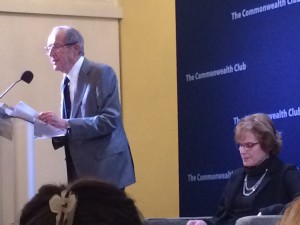
We are thrilled to receive over fifteen schools this year to join us for the 2016 CIF Student Conference!
US
Choate Rosemary Hall, Wallingford, CT Dr. Olga Mohan High School, Los Angeles, CA Harker School, San Jose, CA Punahou School, Honolulu, HI Rock University High School, Janesville, WI Santa Catalina School, Monterey, CA Pacific Grove High School, Pacific Grove, CA
Japanese
Hiroshima Jogakuin Senior High School, Hiroshima, Japan Kansai Soka Senior High School, Katano, Japan Kwassui High School, Nagasaki, Japan Nagasaki Nanzan Senior High School, Nagasaki, Japan Ritsumeikan Uji High School, Kyoto, Japan Soka Senior High School, Tokyo, Japan
Russian
Lyceum, Lesnoy, Russia Gymnasium 41, Nvouralsk, Russia Gymnasium 164, Zelenogorsk, Russia
The Santa Catalina Campus
The Lone Cypress Tree, 17 Miles Drive
To watch live stream online, enter the Adobe Connect Meeting room here!
URL: http://middlebury.adobeconnect.com/cifteachers/
Return to Workshop: Main Page
Tuesday, December 1st
2:00 PM – 2:30 PM (PST)
Welcome Remarks

Video Recording (Both Welcome Remarks and Overview)
Elena Sokova, Deputy Director, James Martin Center for Nonproliferation Studies
2:30 PM – 3:00 PM (PST)
Overview of the CIF Project and Teachers’ Workshop
Video Recording
Masako Toki, Project Manager, Nonproliferation Education Program and CNS Research Associate
3:00 PM – 4:00 PM (PST)
Introduction of 2015-2016 Mini Projects, Expectation and Outcome
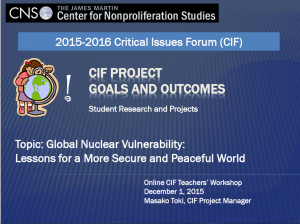
Video Recording
Masako Toki, Project Manager, Nonproliferation Education Program and CNS Research Associate
Wednesday, December 2nd
2:00 PM – 3:30 PM (PST)
Lecture 1: What are Nuclear Weapons, and the Effects of Use?: Scientific Perspectives, Part 1

Video Recording
Dr. Ferenc Dalnoki-Veress, Adjunct Professor and Scientist-in-Residence
Nuclear Glossary
Thursday, December 3rd
2:00 PM – 3:30 PM (PST)
Lecture 2: Nuclear Weapons in Today’s World: Where Are We, How Did We Get Here, and the Future
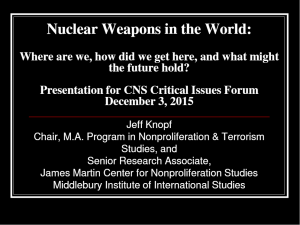
Video Recording
Dr. Jeffrey Knopf, Program Chair, Nonproliferation and Terrorism Studies, MIIS
4:00 PM – 5:00 PM (PST)
Lecture 3: Introduction to this Year’s Topic: Making Sense of Nuclear Vulnerability
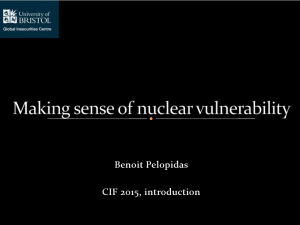
Video Recording
Dr. Benoit Pelopidas, Lecturer in International Relations, University of Bristol, UK
Friday, December 4th
10:00 PM – 11:30 PM (PST)
Lecture 4: U.S.-Soviet/Russia Nuclear Weapons Reduction: An Overview
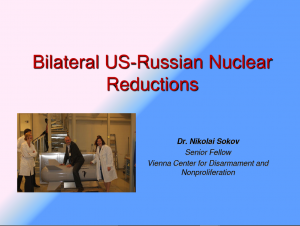
Video Recording
Dr. Nikolai Sokov, CNS Senior Fellow
2:00 PM – 2:50 PM (PST)
Workshop 1: Research Methodologies
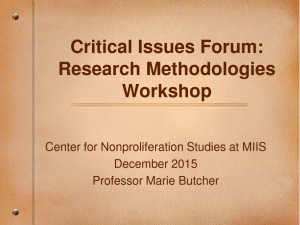
Video Recording
Marie Butcher, English Instructor, MIIS
3:00 PM – 5:00 PM (PST)
Workshop 2: Citing Sources Accurately

Video Recording
Marie Butcher, English Instructor, MIIS
Week 2
Monday, December 7th
7:30 AM – 9:00 AM (PST)
Lecture 5: The NPT Review Process and Future of Nuclear Disarmament
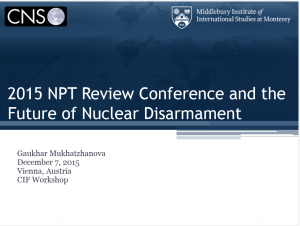
Video Recording
Gaukhar Mukhatzanova, Director, International Organizations and Nonproliferation Program
10:00 AM – 11:30 AM (PST)
Lecture 6: What are Nuclear Weapons, and the Effects of Use?: Scientific Perspectives: Part 2

Video Recording Part 1
Video Recording Part 2
Dr. Ferenc Dalnoki-Veress, Adjunct Professor and Scientist-in-Residence
3:00 PM – 4:30 PM (PST)
Lecture 7: Introduction to the Nuclear Nonproliferation and Disarmament Regimes
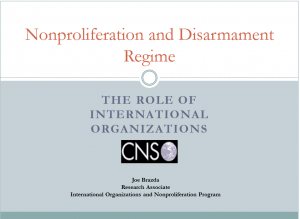
Video Recording
Joe Brazda, Research Associate, International Organizations and Nonproliferation Program
Tuesday, December 8th
2:00 PM – 3:00 PM (PST)
Lecture 8: Global Nuclear Vulnerability 1: Close Calls Case Studies
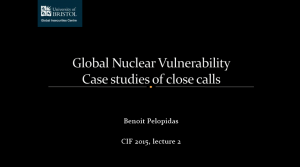
Video Recording
Dr. Benoit Pelopidas, Lecturer in International Relations, University of Bristol, UK
3:00 PM – 4:00 PM (PST)
Lecture 9: Global Nuclear Vulnerability 2: Close Calls Case Studies

Video Recording
Dr. Benoit Pelopidas, Lecturer in International Relations, University of Bristol, UK
Thursday, December 10th
4:00 PM – 4:50 PM (PST)
Workshop 3: Language: Focusing Your Message

Video Recording
Marie Butcher, English Instructor, MIIS
5:00 PM – 5:50 PM (PST)
Workshop 4: Making Effective Presentations
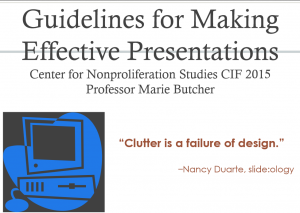
Video Recording
Friday, December 11th
2:00 PM -3:00 PM (PST)
An Overview of the Nuclear Non-proliferation Treaty

Video Recording
Masako Toki, Project Manager, Nonproliferation Education Program and CNS Research Associate
3:00 PM – 3:30 PM (PST)
Introducing Useful Resources
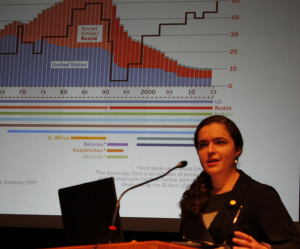
Video Recording
Masako Toki, Project Manager, Nonproliferation Education Program and CNS Research Associate
3:30 PM – 4:00 PM (PST)
Wrap Up Session and Discussion for the Spring Conference
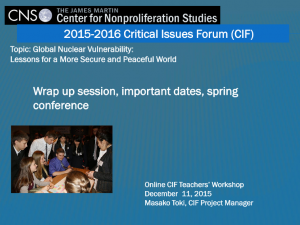
Video Recording
Masako Toki, Project Manager, Nonproliferation Education Program and CNS Research Associate
– See more at: http://sites.miis.edu/criticalissuesforum/2015/11/25/2015-2016-teachers-workshop-agenda/#sthash.LL9QyKp9.dpuf
The NPT in 2015 and the humanitarian initiative
by Dr Nick Ritchie for UNIDIR
Catholic Church Pivots on the Acceptability of Nuclear Deterrence
by Nobuo Hayashi for UNIDIR
Filling the Gap: Report on the third conference on the humanitarian impact of nuclear weapons by Reaching Critical Will
Trust and Distrust in the Global Nuclear Community
by Heather Williams, Chatham House, December 11, 2014.
Masako Toki
April 17, 2014
Students and teachers from Japan and Russia joined their peers from the U.S. at the 2014 spring conference of the Critical Issues Forum project – a nonproliferation and disarmament educational outreach project for high school students – convened by the James Martin Center for Nonproliferation Studies on April 4th and 5th at Santa Catalina School in Monterey.
CIF 2014 photo galleries
Final Presentations
At the Critical Issues Forum (CIF) conference, students from five U.S. high schools in different states (California, Connecticut, Maine, Massachusetts, and Wisconsin), four Russian high schools in closed nuclear cities (Lesnoy, Novouralsk, Ozersk and Zelenogorsk), and six Japanese schools from Hiroshima, Nagasaki, Kanagawa and Tokyo presented their findings on the topic “Nuclear Nonproliferation: Global Opportunities and Regional Challenges.” The CIF program is managed by the James Martin Center for Nonproliferation Studies at the Monterey Institute.
Every year, the CIF project provides opportunities for high school students to address one of the world’s most pressing problems. This year, the CIF project has challenged participants to study the relationship between regional security and international nuclear nonproliferation and disarmament issues. Students identified nuclear nonproliferation and disarmament challenges, evaluated what progress has been made, and envisaged what must be done to make further progress in both areas.
The spring conference is the culmination of the semester-long CIF project that begins with a teacher training workshop. This academic year’s teacher workshop was held in December 2013 using an online conference tool. For the spring conference, all the CIF students completed mini-project 1 and prepared for the spring conference presentations under the guidance of CIF teachers.
Last year, CIF started engaging Japanese students in Hiroshima and Nagasaki, the two cities devastated by atomic bombs in August 1945. This year, Japanese participation expanded to Tokyo and Kanagawa, in the eastern part of Japan. Professor Nobumasa Akiyama of Hitotsubashi University, who is one of the leading experts in the field of nonproliferation and disarmament in Japan, joined the CIF conference as a chair of the CIF-Japan steering committee. In addition, one of the high school students from Hiroshima has been appointed as a “Youth Special Communicator for a World without Nuclear Weapons” as part of a project launched by the Japanese government last year to convey the importance of nuclear disarmament to the world.
Students’ presentations:
All participating students presented and exchanged their findings on their chosen topic in a creative and innovative way, followed by an open discussion centered on a question and answer session with their peers and teachers.
Many schools focused on nonproliferation challenges in the Middle East, such as Iran’s nuclear problem, tensions between Israel and Arab nations surrounding nuclear issues, and a Middle East Zone free of weapons of mass destruction. Some schools examined the nuclear weapons rivalries between India and Pakistan in South Asia. Two of the Japanese schools investigated the volatile security situation in Northeast Asia that has been exacerbated by North Korea’s nuclear and missile tests, and the recent uneasy relationship between Japan and its neighboring countries. In addition to these regional foci, some schools presented US-Russia arms control agreements and the future prospects of bilateral negotiation toward a world free of nuclear weapons.

Students from Kwassui High School, Nagasaki, Present Their Studies on Northeast Asia Nuclear Situation
The CIF project is designed to develop critical thinking skills and to engage students and teachers around issues related to international peace and security. Students were also engaged in interactive and cross-cultural activities during the conference and had the chance to interact with graduate students studying nuclear disarmament issues in the Institute’s Nonproliferation and Terrorism Studies program.
The CIF conference also welcomed Norwegian Consul General in San Francisco Hilde Janne Skorpen as a keynote speaker. She spoke about the Humanitarian Impact of the Use of Nuclear Weapons. This issue has been drawing increasingly attention recently, and many CIF students also mentioned this issue in their presentations. Norway is one of the leading countries in this field and hosted the first conference on humanitarian impact of nuclear weapons in Oslo, in March 2013. As a closing keynote address, Professor Nobumasa Akiyama encouraged all the students to be innovative and creative in thinking about a world free of nuclear weapons.
The CIF project team sincerely hopes that these young leaders for the next generation will be the driving force to accomplish the goals of a world without nuclear weapons. We believe that the CIF project exemplified how education can promote nuclear nonproliferation and disarmament.
This year’s CIF program is funded by the United States-Japan Foundation, a New York–based organization supporting activities to deepen friendship and understanding between Americans and Japanese, and the Tokyo Club, Japan’s oldest and most prestigious gentlemen’s club. The CIF program also receives support from the Chapman Foundation for students in Monterey. For more information on the CIF program, please visit the CIF website at sites.miis.edu/criticalissuesforum, and view this short video.
View this report at CNS website